Register of Persons Holding a Controlled Interest in Land: Explanatory Document
This document is intended to help readers of the Land Reform (Scotland) Act 2016 (Register of Persons Holding a Controlled Interest in Land) (Scotland) Regulations 2021. It should be read alongside the Regulations.
Chapter 2
Who we are seeking to register – Schedules 1 and 2 of the Regulations
79. Schedules 1 and 2 of the Regulations set out the persons to be registered as 'associates' in the Register. Schedule 1 identifies who is an 'associate' for each category of in-scope entity to which the Regulations apply. Schedule 2 sets out the entities that are subject to other transparency regimes and to which the duty in regulation 10 to provide details of controlled interests and associates does not apply.
80. The Regulations take account of existing legislation around transparency of land ownership – including land registration in Scotland – and corporate transparency including, for example, the UK people with significant control register.
Corporate Transparency – People with Significant Control
81. As set out in the previous consultation on a Register of Controlling Interests of June 2016, the people with significant control (PSC) register established in June 2016 under Part 21A of the Companies Act 2006 provides a great deal of information about persons exercising control of entities which may own land in Scotland. The PSC register, which is held by Companies House, is a valuable resource when seeking information about control over decision-making in relation to land.
82. The PSC register covers:
- UK companies;
- Limited Liability Partnerships (LLPs);
- Scottish Limited Partnerships (SLPs);
- Societas Europaeae; and
- Scottish general partnerships where all the general partners are limited companies.
83. Where one of these entities is the legal owner or tenant of land in Scotland, their legal form should be identifiable from the Land Register or Register of Sasines. Companies House maintain a register of company names so they cannot be duplicated. Searchers can use the information in the Land Register or Register of Sasines to access the information about that entity in the PSC register via the Companies House website.
84. The PSC regime was established by the UK Government to address the "problem of corporate opacity" and "tackle the misuse of companies"[3].
85. The PSC regime means that:
- Entities within its scope must investigate their ownership chains to identify their PSCs;
- A person can be registered as a PSC if they meet one or more of the five conditions in relation to the entity. The conditions are based on: shareholdings, holding voting rights, having the right to appoint or remove the persons in charge of the entity, or otherwise being able to exercise significant influence or control over the entity;
- The entity should then contact these people, or others who might know them, to confirm whether they meet one or more of the conditions and, if they do, to provide the required information (the required information includes their name, month and year of birth, address) for inclusion in the entity's PSC register;
- Prospective PSCs must respond to requests for information;
- The information must then be added to the entity's own PSC register and filed at Companies House to be made available on the central public register; and
- Where there are changes in the information to be registered the entity must update the register with Companies House within 28 days.
86. Since the PSC register was created in June 2016, more than 4.7 million PSCs have been entered onto the Register. Companies House statistics indicate that they currently have a compliance rate of 98% and they continue to work to improve this.
87. The PSC regime is a significant step forward in terms of corporate transparency in the UK. It is easy to use and free to access. The Regulations seek, to a large extent, to avoid duplicating the information already publicly available in the PSC register, and avoid replicating the work that has gone into creating and maintaining it. The Regulations require certain basic information to be provided about such entities if they are associates of an owner or tenant of land, but the Regulations generally do not require investigation of the ownership of the types of entity listed in Schedule 2.
Identifying an 'associate'
88. The ability or right of a person to control or direct the decision-making of an individual or entity which owns or tenants land determines whether they are an 'associate' for the purposes of the Regulations. This ability or right is set out in detail in the different parts of Schedule 1, and varies dependent on the nature of the entity.
Contractual or other arrangements with an individual
89. Part 1 of Schedule 1 concerns persons with contractual or other arrangements with an individual.
90. In some cases individuals may own land as a result of a contractual arrangement in which they own it on behalf of another person. It is understood that this formulation is unlikely to be particularly common as such a relationship would more usually be subject to a trust agreement. This sort of contractual arrangement could be made on a nomination or on an agency basis.
91. The Regulations are not intended to impact upon owner-occupier situations in which only one party is registered as the legal owner of the land e.g. a couple where only one party is the legal owner etc. It is also not the intention to capture straightforward leasing arrangements or mortgaging practices.
92. Paragraph 1 of Schedule 1 sets out that this Part applies to situations where a person has entered into a contract or other arrangement with an individual who is the owner or tenant of the land, so that the land is owned or leased on the person's behalf or so that they have the right to exercise or actually exercise significant influence or control over the individual's dealings with the land.
93. Paragraph 2 sets out that this part does not apply where:
- The contract or arrangement between the individual (owner or tenant) and the person is one to which another Part of Schedule 1 applies. This would exclude, for example, trust arrangements as these are covered elsewhere;
- The person's relationship to the individual (owner or tenant) is that of a creditor only. This would exclude banks or building societies from being registered as associates having granted a mortgage to an individual; or
- The person is the landlord of the individual. In this situation the landlord will be registered as the legal owner of the land in the Land Register or Register of Sasines. Where the landlord is themself subject to control, information about this will be available in the Register or elsewhere.
94. Paragraph 2 also sets out a number of scenarios whereby this part does not apply. The scenarios listed include information that is already available i.e. the existence of a proper liferent will be evident from the Land Register or the scenarios represent examples of where we do not consider that an associate would have significant influence or control over decision making in relation to land.
Partnerships
95. Part 2 of Schedule 1 concerns land held by, or on behalf of, partnerships.
96. Scottish partnerships where all the partners are limited companies, SLPs and LLPs are all required to report information to the people with significant control register (PSC). There are, however, no equivalent reporting requirements on Scottish partnerships where at least one partner is an individual or on general partnerships governed by English law.
97. Partnerships under English law do not have legal personality and therefore cannot be the legal owner of land or holder of a lease on their own behalf. Scottish partnerships do have legal capacity and can own the land directly. It is understood that they usually do not hold title to land directly and instead one or more of the partners will typically hold the land in 'trust' for the partnership. English and Scottish partnerships are therefore treated in the same way in these Regulations.
98. Where one or more of the partners holds the land in trust for the partnership, those partners will be recorded as the legal owner of the land. The trust relationship by which the land is held may not be apparent from the Land Register. The connection of the legal owner and the land in question to the partnership may not therefore be discernible from the Land Register either.
99. Although RoS systems allow partners to register their title as trustees on behalf of the Partnership, and include the name of the partners in the Land Register entry as trustees, this is not a requirement. It is also not required for such an entry to be updated to reflect changes in the makeup of the partners or trustees.
100. Paragraph 3(a) of Schedule 1 sets out that this Part applies where a person who owns or leases land does so as a partnership or on its behalf, or is a partnership. This only applies where the partnership in question is a Scottish partnership where at least one partner is an individual or a general partnership governed by English law.
101. Paragraph 3(b) sets out that an associate in respect of such an owner or tenant is a person who:
(i) is a general partner of the recorded person, but is not registered as owning or leasing the land;
(ii) is a general partner of another partnership which is (of itself) a partner of the recorded person;
(iii) is an individual who has significant influence or control over a relevant entity which is a partner of the recorded person; or
(iv) is an individual who has the right to exercise, or who actually exercises, significant influence or control over the recorded person or a partnership in which the recorded person is a partner. This is defined in greater detail below.
102. The following diagrams set out examples of how these proposals will apply where land is owned or leased by or on behalf of a partnership. They illustrate the relationship between the owner or the tenant of the land (who becomes the recorded person) and the persons who can exercise significant influence or control over them (the associates) as set out in Part 2, Paragraph 3(a)(i) of this Schedule. The diagrams also note the duties that apply to the owner or tenant as a recorded person and the associates.
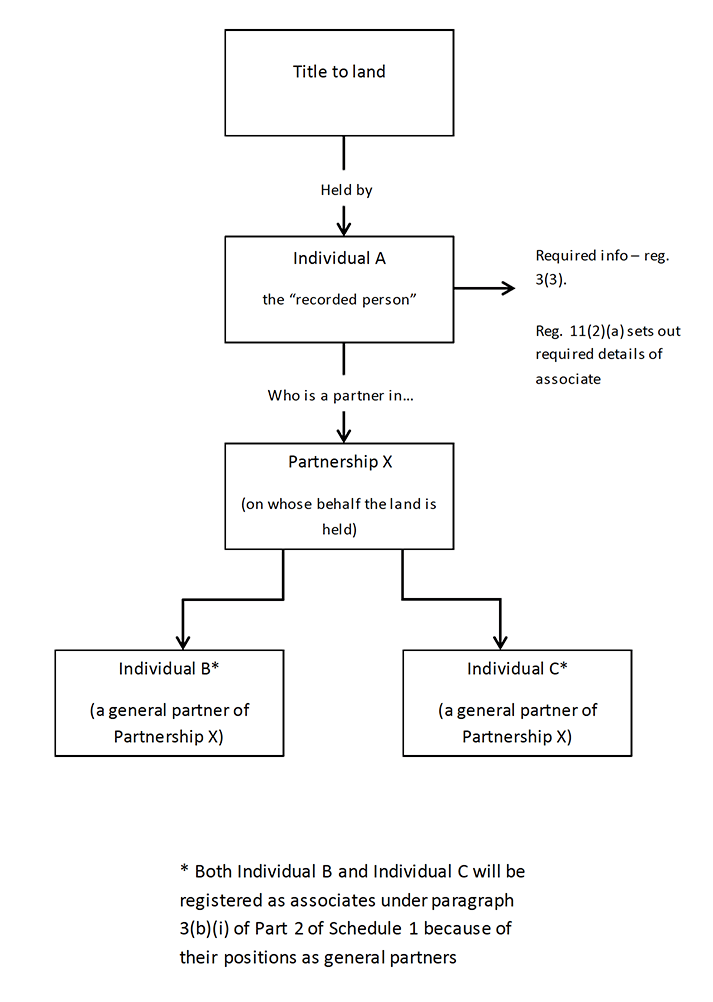
Diagram Description
Diagram four illustrates an example of how the legislation applies where land is owned or leased by or on behalf of a partnership. Where the title to land is held by Individual A, that person is the recorded person and must supply the information required for the Register under regulation 3(3). The details are set out under regulation 11(2)(a). If Individual A is a partner in Partnership X (on whose behalf the land is held), other general partners of Partnership X, Individuals B and C, will be registered as associates due to their positions as general partners in Partnership X.
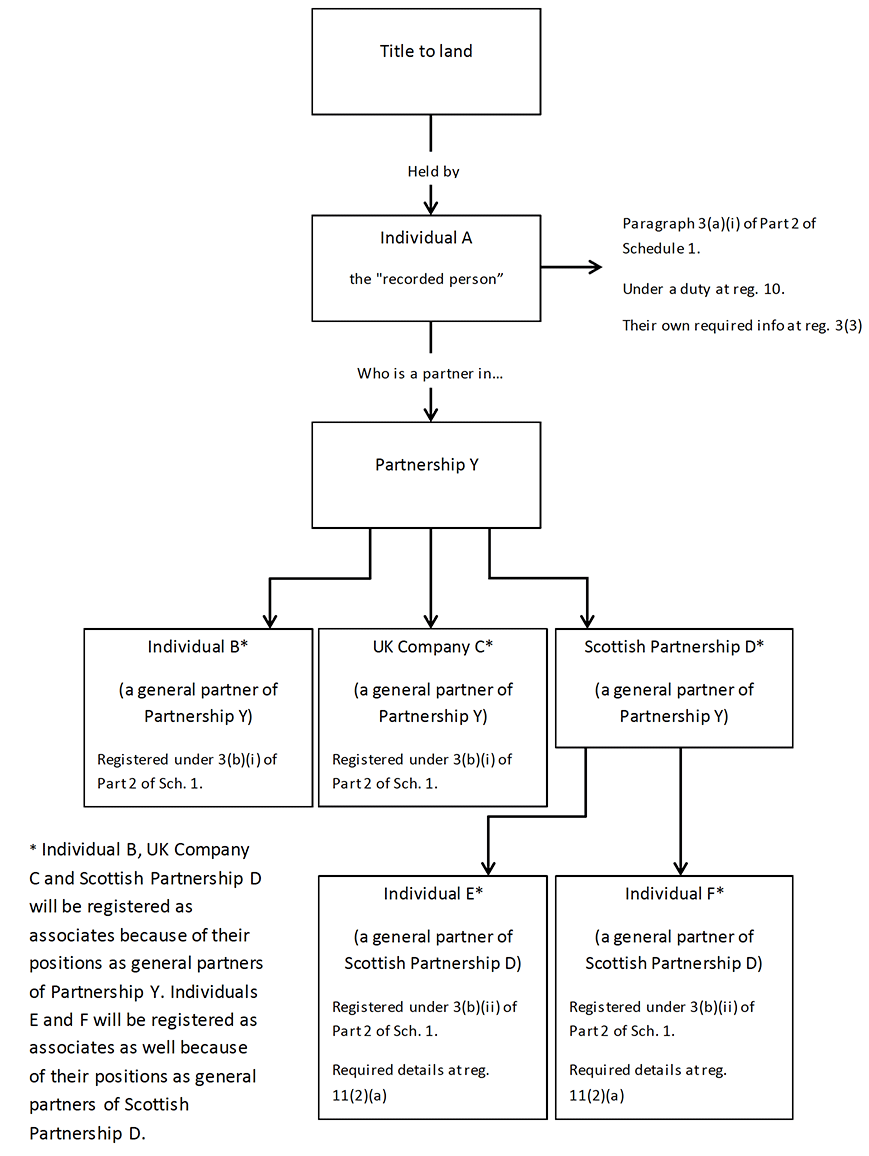
Diagram Description
Diagram five illustrates a second example of how the legislation applies to partnerships. The title to land is held by Individual A, a partner in Partnership Y. Individual B, UK company C and Scottish Partnership D are all general partners of Partnership Y. Individuals E and F are general partners of Scottish Partnership D. Individual B, UK Company C and Scottish Partnership D will be registered as associates because of their positions as general partners of Partnership Y. Individuals E and F will be registered as associates as well because of their positions as general partners of Scottish Partnership D.
103. Paragraph 4 of Schedule 1 sets out cases in which this Part does not apply.
104. The diagram below illustrates how these proposals will capture relationships of significant influence or control not based on a position e.g. as a general partner. This diagram is an extension of diagram 3. As per diagram 3 Individuals C and D would be registered as associates by virtue of their position as general partners.
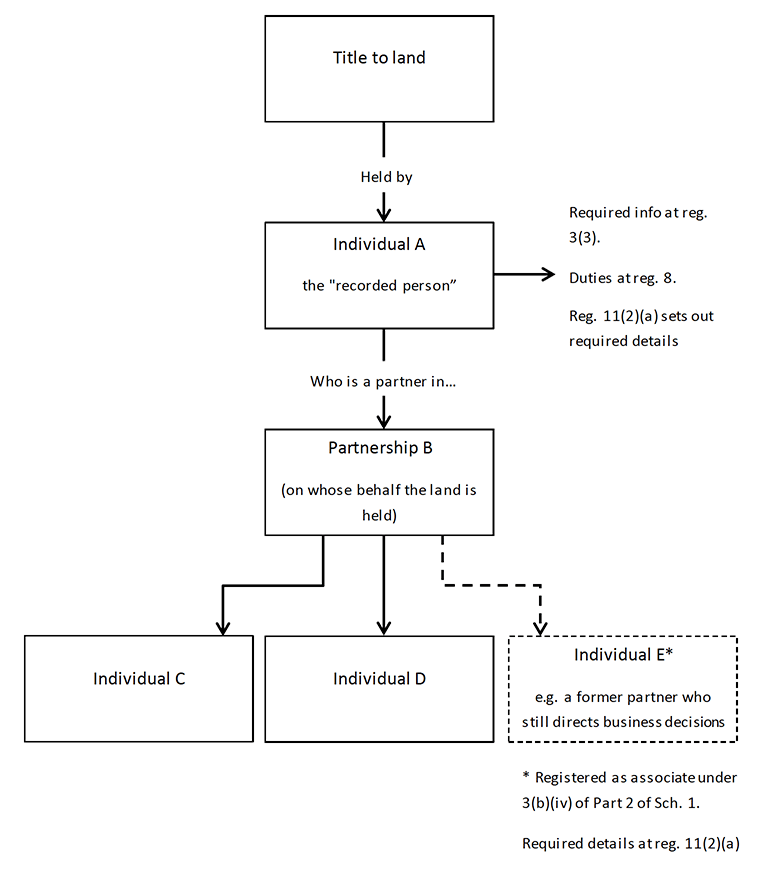
Diagram Description
Diagram six illustrates how the legislation captures relationships of significant influence or control not based, for example, on a position as a general partner. This diagram is an extension of diagram 3. The title to land is held by Individual A, the recorded person and a partner in Partnership B. Individuals C and D would be registered as associates by virtue of their position as general partners of Partnership B. Individual E is, for example, a former partner who still directs business decisions and therefore is also registered as an associate under section 3(b)(iv) of Part 2 of Schedule 1.
105. Paragraph 4 sets out the relationships which a person may have to a partnership, on the sole basis of which they cannot be considered an associate. This includes paid professional advisors or creditors. In these cases control remains with the partners and persons identified above. This is because the inclusion of such persons in the Register would blur users' understanding of the situation whilst placing an additional burden of reporting on persons not considered to have a controlling interest. It may be possible for such people to nonetheless meet the conditions to be considered an associate should they meet other conditions in addition to the role defined in 4(2).
106. Paragraph 5 sets out the definition of 'general partner' and 'relevant entity' for the purposes of this Part. Paragraph 5(c) sets out that examples of significant influence or control include persons who:
(i) Have the right to unilaterally take or veto decisions about the governance or running of the partnership.
(ii) Have the right to appoint or remove any of the partners of the partnership.
(iii) Are able to influence the decision-making of the partnership without holding a formal governance position within the partnership.
107. Paragraph 5 proposes that general partners should be registered as associates as they can unilaterally contractually bind the partnership, and they typically can take a significant role in the management of the partnership, decisions about the disposal of its assets and any eventual winding up of the partnership. These activities can all impact upon how the partnership engages with the use or disposal of its assets including land. There is therefore a clear imperative for individuals or communities who wish to engage with a partnership about land to know who the general partners are.
108. The Regulations do not provide for limited partners to be registered as associates, as their status as limited partners is contingent on not being involved in the management of the partnership. Should they involve themselves in management decisions they will lose their status as limited partners. They will therefore not be able to influence how the partnership engages with its assets including land.
Trusts
109. Part 3 of Schedule 1 concerns land held by a person as a trustee of, or otherwise on behalf of, a trust.
110. Land in Scotland may be held in trust for a variety of reasons. It may be placed in trust to deliver benefits to family members and ultimately to be inherited by a later generation. It may be placed in trust on behalf of a number of investors and to support a commercial venture. Land may also be placed in trust to deliver charitable benefits to a specific group or to the population at large.
111. Where land is placed in trust in Scotland there are typically several elements present:
- The truster who is placing the assets (in this case the land) into trust;
- The trustees who become the legal owners of the assets;
- The trust deed which sets out the assets to be placed in trust and makes any additional specification about the powers of the trustees or governance of the trust etc;
- The beneficiaries who receive certain benefits as set out in the trust deed. This may include a wide group of people (such as a local community) who are to benefit from a charitable trust, or a family member who is to benefit from land placed in trust by a relative.
112. In the Land Registers of Scotland, land that is held in trust will record the trustees as the legal owners of the land as a result of their position as a trustee. Where this is recorded, the Land Register title may not be updated to reflect changes in the trustees. For example, title may be recorded in the name of "The trustees of Mr Smith and their successors in office". Where the trustees are named, the Land Register will show their names and addresses and the title may be updated to reflect changes in the trustees. A Land Register title may also show the individual or entity on whose behalf they hold the land. This is not, however, a legal requirement and it is not clear how common this is.
113. The Land Register may also not be updated to reflect changes in the trustees. For example, if Ms Smith is the legal owner of a piece of land as a result of their position as a trustee, the Land Register may show the legal owner as 'Ms Smith and her successors in office'. If Ms Smith is no longer a trustee having been replaced by Mr McDonald, that will not be apparent from the Land Register unless an update is requested.
114. Trustees are under fiduciary duties to act in the interests of the beneficiaries. These duties will guide and influence their decision making. The trust deed may also make requirements of the trustees and thereby influence their decision making. For example, it may specify that a certain piece of land is to be kept as a garden in perpetuity, or that a building must continue to fulfil a certain role.
115. The trust deed will also not generally be publically available.
116. Once the trust is constituted, there may be no further engagement between the truster and the trustees, and the truster is not normally one of the beneficiaries.
117. This is the typical arrangement used for trusts constituted under Scots law and, it is understood, for trusts constituted under English law as well, although there are differences between Scots law and English law in relation to trusts. There may be some variation in these arrangements across trusts constituted in other jurisdictions and the proposed Regulations are accordingly designed to be able to address a range of potential formulations. There are concerns that trusts can be subject to very unusual structures including truster-as-beneficiary trusts, or that nominee trustees can be put in place to obscure the retention of control by the truster.
118. Part 3 of Schedule 1 is intended to be applicable to trusts constituted under Scots law, English law and the law of other jurisdictions. They are also intended to apply equally to public, private and charitable trusts.
119. Paragraph 6(a) of Schedule 1 sets out that this Part applies where a person owns or leases the land as a trustee of, or otherwise on behalf of, a trust. Paragraph 6(b) sets out that an associate in respect of a trustee is a person who:
(i) Is a trustee of the trust, but is not registered as being the owner or tenant of the land;
(ii) Is an individual who has significant influence or control over a relevant entity which is a trustee of the recorded person;
(iii) Is an individual who has the right to exercise, or who actually exercises, significant influence or control over the recorded person or the trust. This is expanded on in paragraph 8.
120. The diagrams below illustrate the relationship between the owner or tenant of the land (who will be the recorded person) and their associates as apply to trusts.
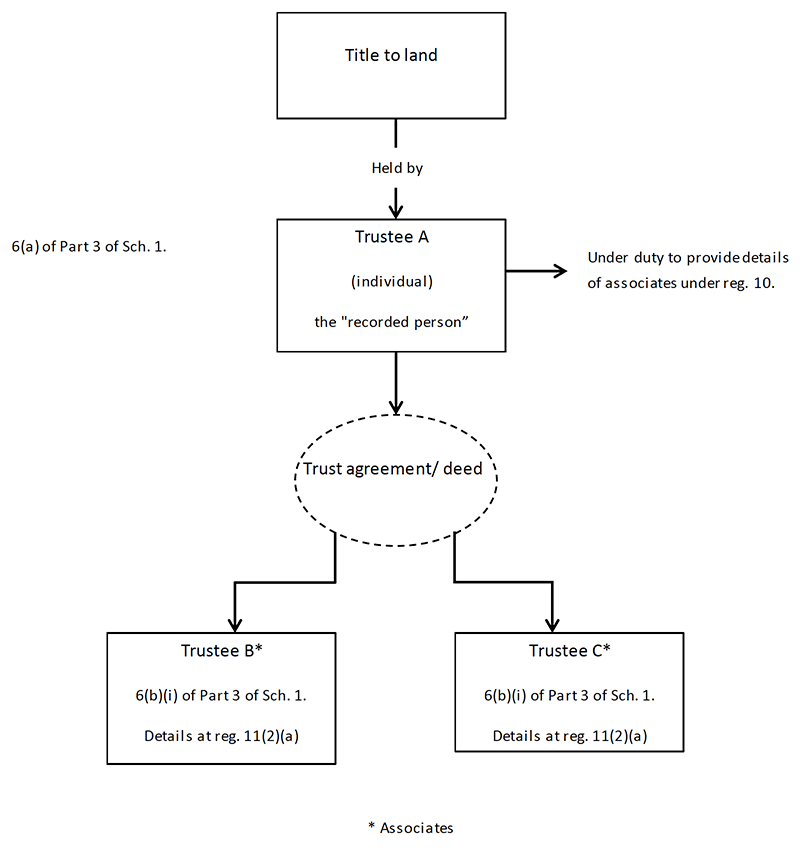
Diagram Description
Diagram seven illustrates an example of how the relationship between the owner or tenant of the land (who will be the recorded person) and their associates apply to trusts. Title to land is held by Trustee A (the recorded person) who has a duty to provide details of associates under regulation 10. Where the trust agreement or deed names Trustees B and C as additional current Trustees, both would be registered as associates under section 6(b)(i) of Part 3 of Schedule 1. Trustee A must provide details of each under associate as set out under regulation 11(2)(a).
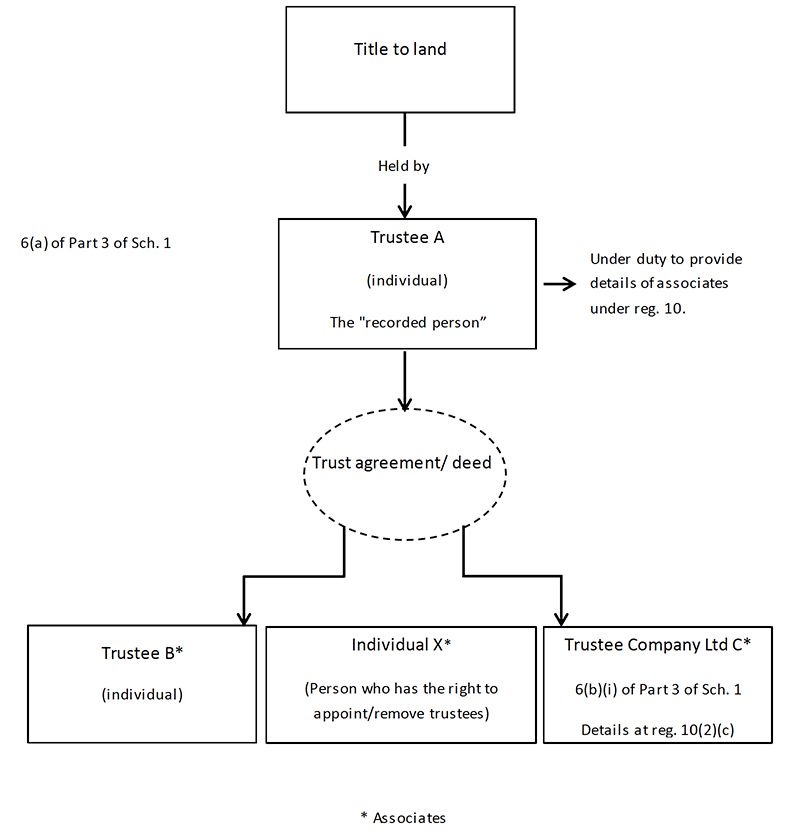
Diagram Description
Diagram eight illustrates how the relationship between the owner or tenant of the land and their associates apply to trusts. Title to land is held by Trustee A (the recorded person) who has a duty to provide details of associates under regulation 10. Where the trust agreement or deed names Trustee B, Individual X (who has the right to appoint/remove trustees) and Trustee Company Ltd C as additional current Trustees, all would be registered as associates. Section 6(b)(i) of Part 3 of Schedule 1 applies in the case of Trustee Company Ltd C, details must be provided under regulation 10(2)(c).
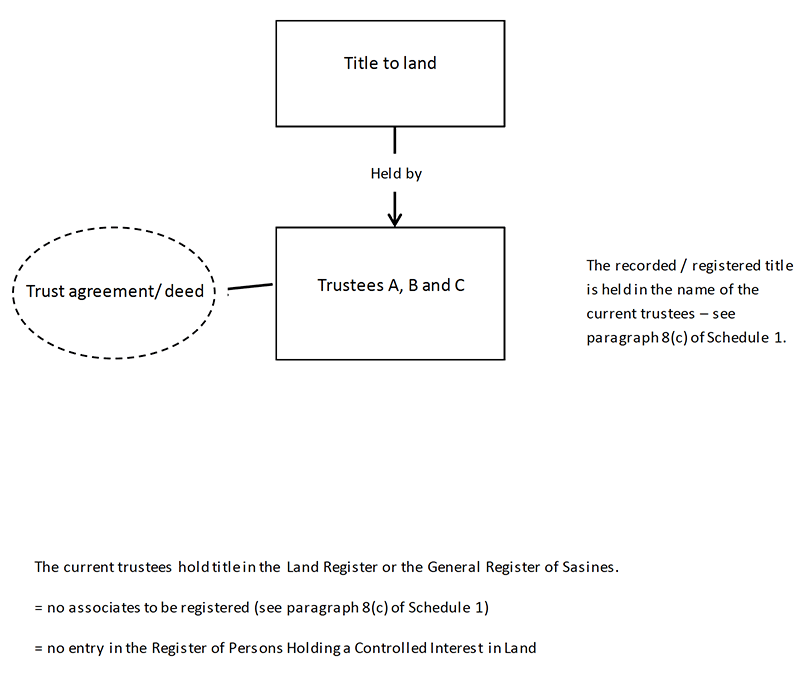
Diagram Description
Diagram nine illustrates another example of how the relationship between the owner or tenant of the land and their associates apply to trusts. Title to land is held by Trustees A, B and C who are the current Trustees. The recorded / registered title is held in the name of the current trustees – see paragraph 8(c) of Schedule 1. The current trustees hold title in the Land Register or the General Register of Sasines. This means there are no associates to be registered and no entry in the Register of Persons Holding a Controlled Interest in Land.
121. Paragraph 7 sets out cases in which this Part does not apply. Paragraph 7(1)(a) excludes situations where the owner or tenant of the land owns or leases the land as a trustee of a trust created for the purposes of insolvency or sequestration. This is because the trust has been created for a specific, known purpose and the trustees will be subject to legally binding duties to take certain decisions. Such a situation will only persist for a limited time until the trustees have discharged their legal duties. Paragraph 7(1)(b) excludes situations where the owner or tenant of the land does so on behalf of a partnership. In that case Part 2 of Schedule 1 would apply. Paragraph 7(1)(c) excludes situations where the recorded person owns or tenants land on behalf of the members of an unincorporated body to which Part 4 of Schedule 1 applies.
122. Paragraph 7(2) sets out the relationships which a person may have to a trust and on the sole basis of which they cannot be considered an associate. This includes paid professional advisors or creditors. In these cases control remains with the trustees and persons identified above. The inclusion of such persons in the Register would blur users' understanding of the situation, whilst placing an additional burden of reporting on persons not considered to have control over the owner or tenant. It may be possible for such people nonetheless to be considered an associate should they meet other conditions specified elsewhere in the Regulations in addition to the role defined in 7(2). Paragraph 7(2)(d) excludes bodies who exercise control by virtue of a statutory function conferred by enactment, as the control would be clear in terms of the legislation.
123. Paragraph 8(a) defines 'relevant entity' for the purposes of this Part. 8(b) sets out that examples of significant influence or control include:
(i) Persons who have the right to appoint or remove a trustee (other than by application to the court). This power may typically be provided for in the trust agreements of commercial trusts;
(ii) Persons who have the right to direct the distribution of assets or funds, or to direct investment decisions of the trust. This may also be provided for in a trust agreement;
(iii) Persons who have the right to amend the trust deed. We are not aware that this is a common formulation of trust deeds made under Scots law. It may, however, be used in trust deeds made in another jurisdiction to reserve a role for the truster in the running of the trust;
(iv) Persons who have the right to revoke the trust. This may include of-age sole beneficiaries of a bare trust who can unilaterally revoke the trust.
(v) Persons who can influence the decision-making of the trust without holding a formal governance position within the trust.
124. Paragraph 8(c) deals with the situation where there are multiple recorded persons in relation to a piece of land. In such a situation, each recorded person could, by virtue of paragraph 6(b)(iii), exercise significant control over each other, and so should be registered as an associate. Paragraph 8(c) provides that in such a case, someone who is already a recorded person in respect of the land does not need to be registered as an associate in relation to that land. This is to reduce unnecessary duplication where someone is already on the register.
125. There can be substantial variation in the powers of individual trustees, and in the governance of the trust, which may be determined by the truster and in the trust deed (as well as the typically variable influence of trustees depending on how many of them take part in a vote). However it is considered that typically all trustees are in a position to influence or control the decision making of the trust.
126. The roles set out in paragraph 8(a) are examples of persons who can influence or direct the conduct of the trust including in relation to land it may own. There is a clear imperative for communities or individuals who wish to engage with a trust in regard to land it owns or tenants to be able to engage with such persons.
127. The Regulations do not require registration of beneficiaries as a matter of course. This is because a purely financial interest does not equate to engagement in the governance of a landowning body or entity. Where the beneficiaries are engaged in the control or governance of the trust then it is expected they would be registered as associates on that basis.
Unincorporated Associations
128. Part 4 of Schedule 1 concerns land held as a trustee of, or otherwise on behalf of, the members of an unincorporated association.
129. Unincorporated associations do not have legal personality and therefore cannot own land in their own right. An unincorporated association is typically a small body that may be a charity or another voluntary or community group. Common examples include village hall associations, sports clubs and faith and belief groups.
130. The Office of the Scottish Charity Regulator, the Scottish Council for Voluntary Organisations, the Scottish Sports Association and other affected stakeholders have contributed to understanding of how unincorporated associations own land and govern themselves. As set out below, there are a number of complicating factors in this area.
131. As unincorporated associations cannot hold title to land in their own name, a trustee or trustees will typically hold the title to land in trust on behalf of an unincorporated association. The trustee(s) will be shown on the Land Register as the legal owners of the land, or as the tenants of a registrable lease. That they are doing so on behalf of the unincorporated association may not, however, be clear.
132. The trustee(s) recorded as the legal owner(s) of the land (the property trustees) may be the persons involved in the governance of the unincorporated association or a subset of them. In other cases the property trustees may be entirely unrelated. Control over the land may be exercised day-to-day by the association itself, but decisions to dispose of the land, for example, would require the agreement of the property trustees. In some situations the property trustees and the management of the association can disagree about decisions relating to the land and the exercise of their respective functions.
133. There are, however, additional complicating factors. In many cases the arrangement itself may not be known by the persons involved in it. For example, some associations have previously understood themselves to be the legal owners of the land. In other cases the original trustees may have historically been appointed ex officio i.e. based on their position as the local bank manager or parish priest. The current officeholders may not be aware of their position as a property trustee, or the position itself may have been abolished. There is not currently complete data on the number of unincorporated associations who are active or who are landowners.
134. Paragraph 9(a) of Schedule 1 sets out that this Part applies when a person owns or leases land as a trustee of, or otherwise on behalf of, the members of an unincorporated association.
135. Paragraph 9(b) sets out that an associate in respect of such a person would be a person who:
(i) Is responsible for the general control and management of the administration of the body, and
(ii) Is not recorded as the legal owner of the land.
136. Paragraph 10 sets out the relationships which a person may have to a body, on the sole basis of which they cannot be considered an associate. This includes paid professional advisors or creditors. In these cases it is considered that control remains with the persons identified as a result of paragraph 9(b). The inclusion of such persons in the Register would blur users' understanding of the situation whilst placing an additional burden of reporting on persons who do not have a controlling interest in the land owner or tenant.
137. Paragraph 11 sets out that a person is responsible for the general control and management of the administration of a body if they hold an office or position (such as chair or treasurer etc.).
138. The effect of these proposals is intended to be that the office holders within the management committee be registered as associates in respect of the unincorporated association. The property trustees would be registered as the recorded person(s).
139. These proposals reflect current understanding of the way in which unincorporated associations function. They are frequently informal and dependant on certain key individuals within it. Unincorporated associations can also be reliant on volunteers and may be subject to regular changes of personnel within management committees or bodies of trustees –this is less likely to be the case within the individuals engaged in the management of the body. These proposals are therefore intended to both deliver increased information but also to be manageable for associations to implement.
Overseas Legal Entities
140. Part 5 of Schedule 1 concerns land in Scotland owned or leased by overseas entities.
141. Overseas entities which own land in Scotland will be recorded as the legal owner of the land or tenant of a lease and their name and registered address will be recorded in the Land Register. This is different to the other situations, such as with trusts, where it is not always clear who is the owner of the land.
142. Where they are not subject to reporting requirements elsewhere however, that entity may be opaque with no opportunity to identify persons involved in its governance or decision making.
143. Paragraph 12 of Schedule 1 sets out that an associate in respect of an overseas legal entity be a person who:
(i) Directly or indirectly holds more than 25% of the voting rights in the recorded person;
(ii) Directly or indirectly holds the power to appoint or remove a majority of the board of directors of the recorded person (or if it doesn't have a board, the equivalent management body);
(iii) Has the right to exercise, or actually exercises, significant influence or control over a partnership or unincorporated body which is not a legal entity or a trust, but in respect of which paragraphs (i) or (ii) would apply if the partnership, body or trust were an individual; or
(iv) Otherwise has the right to exercise, or actually exercises, significant influence or control over the decision-making of the recorded person, particularly in respect of its dealings with the land. This is defined in more detail below.
144. These conditions have been previously used in the EU 4th Anti-Money Laundering Directive, and in the subsequent development of the UK Government's PSC register. They follow the formulation developed by the Financial Action Task Force, of which the UK is a member. This is the internationally accepted best practice for identifying control of corporate entities.
145. The following diagrams illustrate the relationship between an overseas entity who is an owner or tenant of land (who will be the recorded person) and their associates. Diagram 10 shows how the Regulations will apply to straightforward corporate structures. Diagrams 11 and 12 show how the Regulations will apply to 'chains' of corporate ownership.
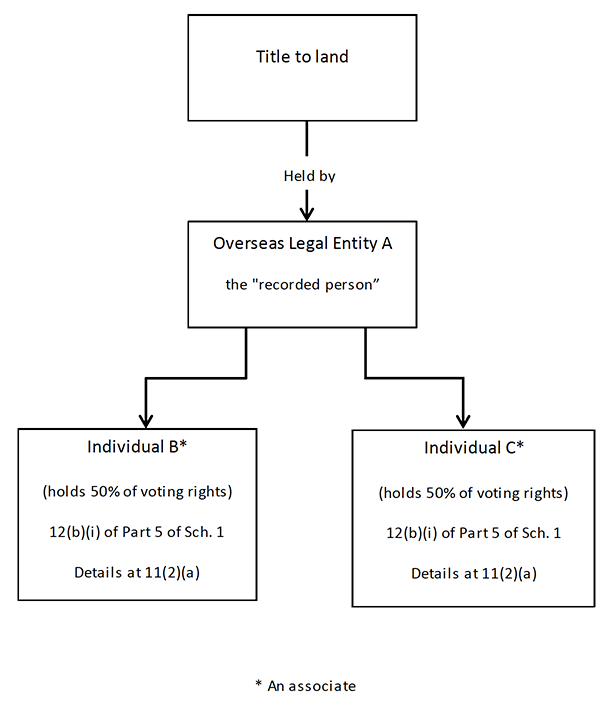
Diagram Description
Diagram ten illustrates the relationship between an overseas entity who is an owner or tenant of land (who will be the recorded person) and their associates. It shows how the Regulations will apply to straightforward corporate structures. Title to land is held by Overseas Legal Entity A which is the recorded person. Individuals B and C each hold 50% of voting rights in Entity A and would therefore be registered as associates under section 12(b)(i) of Part 5 of Schedule 1. Details of these must be provided according to regulation 11(2)(a).
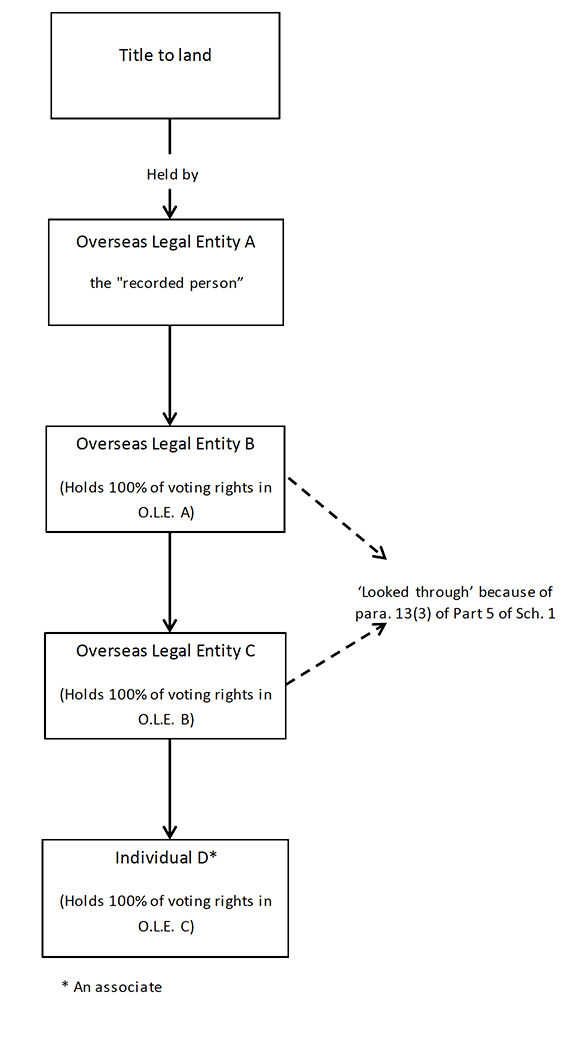
Diagram Description
Diagram eleven illustrates how the Regulations will apply to ‘chains’ of corporate ownership. Title to land is held by Overseas Legal Entity A which is the recorded person. Overseas Legal Entity B holds 100% of voting rights in Overseas Legal Entity A and Overseas Legal Entity C holds 100% of voting rights in Overseas Legal Entity C. Both are ‘looked through’ because of paragraph 13(3) of Part 5 of Schedule 1. However, In Individual D who holds 100% of voting rights in Overseas Legal Entity C, would be registered as an associate.
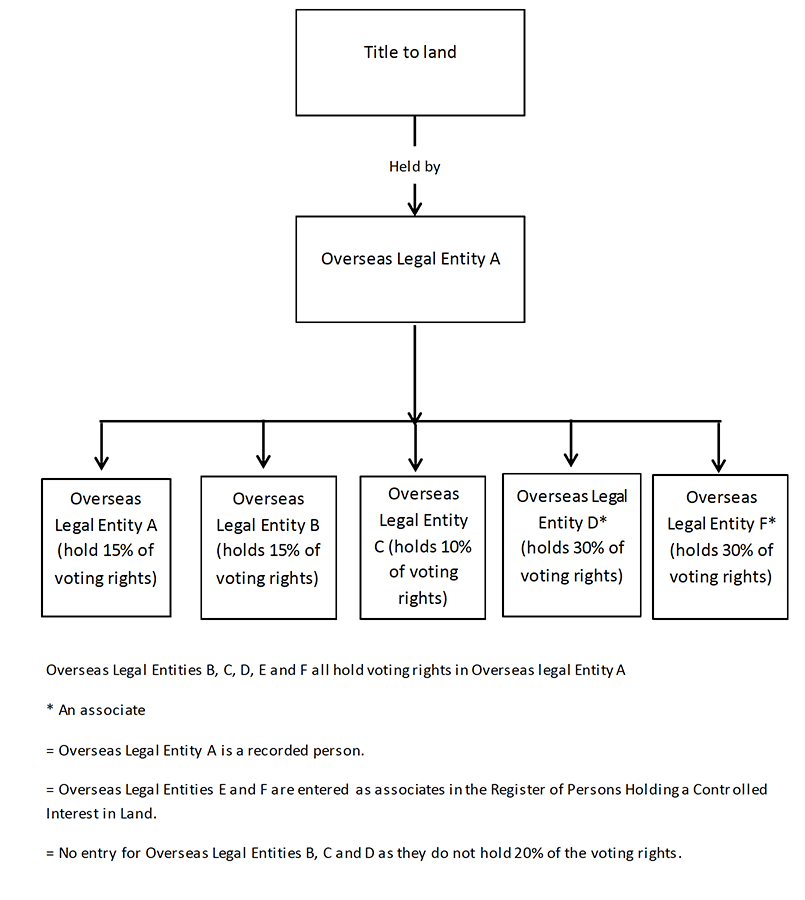
Diagram Description
Diagram twelve illustrates how the Regulations will apply to ‘chains’ of corporate ownership. Title to land is held by Overseas Legal Entity A. It holds 15% of voting rights in itself. Overseas Legal Entity B and Overseas Legal Entity C hold 15% and 10% of voting rights respectively in Overseas legal Entity A. Overseas Legal Entities D and F each hold 30% of voting rights. Therefore Overseas Legal Entities D and F are both registered as associates but there are no entries for the remaining Overseas Legal Entities as they do not hold more than 20% of the voting rights.
146. The Regulations do not propose that persons be registered as associates in respect of their shareholdings for the same reason that it is not proposed to register beneficiaries of a trust. Holding a purely financial interest in land does not in itself equate to control over the land owner or tenant.
147. Paragraph 13(1) of Schedule 1 sets out the relationships which a person may have to an overseas legal entity, on the sole basis of which they cannot be considered an associate. This includes paid professional advisors, employees of the entity or creditors. In these cases it is considered that control remains with the persons identified above and the inclusion of such persons in the Register would blur users' understanding of the situation whilst placing an additional burden of reporting on persons not considered relevant. It may be possible for such people to nonetheless be considered an associate should they meet the other conditions in paragraph 12(b).
148. Paragraphs 13(3) and 13(4) set out how the regime will deal with ownership 'chains' – where title to land is held by an overseas entity which in turn is owned by another overseas entity and so on. In this situation 13(3) sets out that where an overseas entity is part of a majority-ownership chain which includes the recorded person, and there is a person other than an overseas entity which would meet a condition in paragraph 12(b) through the overseas entity or the chain, then this Part does not apply to the overseas entity in question. This means that the Regulations would result in the registration of, for example, an individual who owns a succession of overseas companies which ends with the recorded person, rather than the registration of all the engaged overseas companies themselves. It is considered that this better meets the policy goal of increasing transparency as to the persons controlling decision making in relation to land, rather than registering potentially opaque entities without requiring that they disclose the persons controlling their decision making.
149. Paragraph 15 sets out that examples of significant influence or control include in particular where:
(i) A person has absolute decision rights or absolute veto rights over decisions related to the running of the business of the company;
(ii) A person's recommendations are always or almost always followed by shareholders who hold the majority of the voting rights in the company; or
(iii) A person is significantly involved in the management and direction of the company.
150. Paragraphs 16 to 26 define terms in relation to this Part.
151. It is recognised that there will not always be an individual behind an overseas legal entity which owns land in Scotland. Diagram 13 sets out a structure which may have this result.
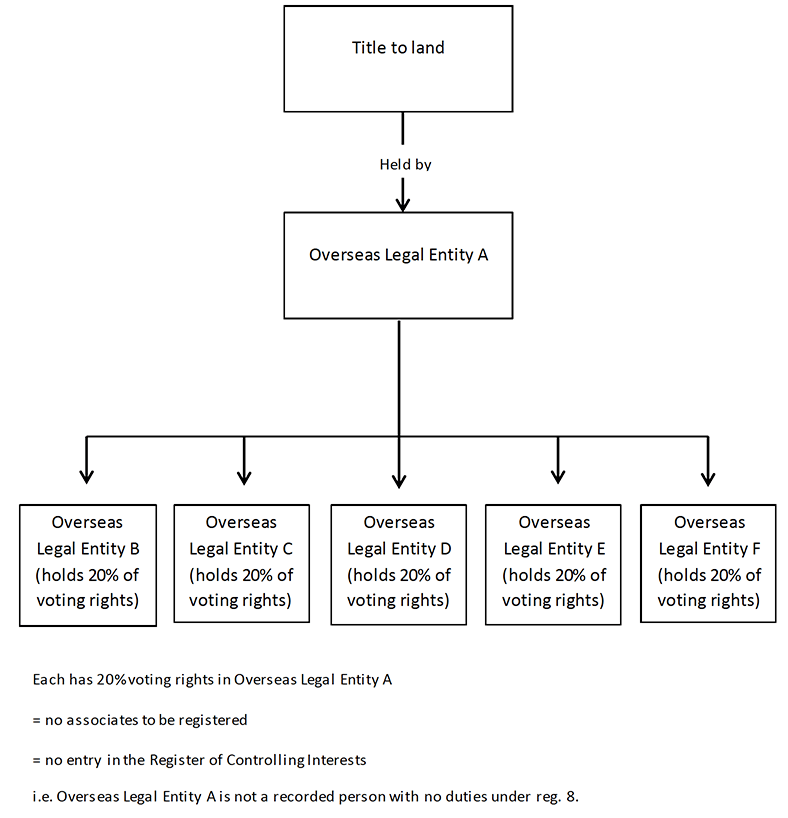
Diagram Description
Diagram thirteen illustrates a case where there may be no individual behind an overseas legal entity which owns land in Scotland. Title to land is held by Overseas Legal Entity A which is not a recorded person and therefore has no duties under regulation 8. Overseas Legal Entities B, C, D, E and F each hold 20% of the voting rights in Overseas Legal Entity A. Therefore Overseas Legal Entities B, C, D, E and F are not registered as associates in the Register as they do not hold more than 20% of the voting rights each.
Schedule 2
152. Schedule 2 lists persons subject to other transparency regimes who, as set out in regulation 10(2), do not have to double report similar information in the Register of Controlling Interests. This will apply where they are the owner or tenant of land. Entities listed in Schedule 2 may still be recorded as associates in respect of a legal owner or tenant of land.
Charitable incorporated associations
153. Paragraph 1 of Schedule 2 sets outs that charitable incorporated organisations (CIOs) and Scottish charitable incorporated organisations (SCIOs) are not subject to the Regulations. CIOs are active in England and Wales – SCIOs are their Scottish equivalent. There is no equivalent body provided for in Northern Irish legislation.
154. Scottish Ministers introduced the SCIO legal form in 2011 to allow charities to be incorporated but to be administered and regulated by a single body, OSCR. The Executive Note for the Scottish Charitable Incorporated Organisations Regulations 2011 sets this out: The SCIO will allow Scottish charities to enjoy the benefits of incorporation, notably limited liability for members and legal personality for the charity, without requiring them to become companies or industrial and provident societies. SCIOs will be registered with and regulated by the Office of the Scottish Charity Regulator (OSCR).[4]
155. SCIOs are legal entities and so can hold title to land in their own name. Where a SCIO owns land in Scotland the Land Register will show the name of the SCIO and its registered office address. Additionally, it is expected that SCIO names will soon be registered with Companies House which will offer assurance that the proprietor recorded on the Land Register is the same as that entered onto OSCR's register.
156. It is considered that control of SCIOs is generally exercised by the charity trustees. Even in a two-tier structure, where some decision making resides with the members, the trustees still play the key role in governance of the SCIO. Any person can request that the SCIOs provide them with the names and addresses of its trustees. The SCIO then has to do so within 28 days of a request by a third party – this duty is advertised on the SCIOs page on the OSCR website. That list should be updated by the SCIO within 28 days of a change and anyone requesting a copy should be notified of any changes that are still to be made.
157. On that basis that the information is already publicly available, the Regulations do not require SCIOs to report in the Register. CIOs follow similar structures and accordingly are also not required to report to the new Register.
Companies and other bodies corporate
158. Paragraphs 2(1), 2(2), and 2(3) do not require entities who have to report information to the PSC register to also report to the Register of Controlling Interests
159. As described above, the PSC register applies to: UK companies, Limited Liability Partnerships (LLPs), Scottish Limited Partnerships (SLPs), Societas Europaeae and Scottish partnerships where all the partners are limited companies.
160. The definition of a person with significant control in relation to each category of entity is listed below.
UK companies
- (i) Directly or indirectly holding more than 25% of the shares,
- (ii) Directly or indirectly holding more than 25% of the voting rights,
- (iii) Directly or indirectly holding the right to appoint or remove a majority of directors,
- (iv) Otherwise having the right to exercise, or actually exercising, significant influence or control,
- (v) Having the right to exercise, or actually exercising, significant influence or control over the activities of a trust or firm which is not a legal entity, but would itself satisfy any of the first four conditions if it were an individual.
LLPs
- (i) Directly or indirectly holding rights over more than 25% of the surplus assets on a winding up,
- (ii) Directly or indirectly holding more than 25% of the voting rights,
- (iii) Directly or indirectly holding the right to appoint or remove the majority of those involved in management,
- (iv) Otherwise having the right to exercise, or actually exercising, significant influence or control,
- (v) Holding the right to exercise, or actually exercising, significant influence or control over the activities of a trust or firm which is not a legal entity, but would itself satisfy any of the first four conditions if it were an individual.
Eligible Scottish partnerships
- (i) Directly or indirectly holding rights over more than 25% of the surplus assets on a winding up,
- (ii) Directly or indirectly holding more than 25% of the voting rights,
- (iii) Directly or indirectly holding the right to appoint or remove the majority of those involved in management,
- (iv) Otherwise having the right to exercise, or actually exercising, significant influence or control,
- (v) Holding the right to exercise, or actually exercising, significant influence or control over the activities of a trust or firm which is not a legal entity, but would itself satisfy any of the first four conditions if it were an individual.
Societas Europaeae
- (i) Directly or indirectly holding more than 25% of the shares,
- (ii) Directly or indirectly holding more than 25% of the voting rights,
- (iii) Directly or indirectly holding the right to appoint or remove a majority of directors,
- (iv) Otherwise having the right to exercise, or actually exercising, significant influence or control,
- (v) Having the right to exercise, or actually exercising, significant influence or control over the activities of a trust or firm which is not a legal entity, but would itself satisfy any of the first four conditions if it were an individual.
161. The PSC register is intended to reveal ownership and control of corporate entities and has based the above conditions on international best standards in order to do so.
162. Further to this, paragraph 2(9) of Schedule 2 does not require an overseas entity to report if that entity has shares admitted to trading on a regulated market in an EEA state or other markets listed in legislation. Having shares admitted for trading on these markets requires the entity to meet a number of reporting requirements. These requirements are considered equivalent to those set out by the PSC regime. It is therefore considered that the transparency requirements in relation to these entities are already met and there is no policy gain in requiring them to also provide information for our Register.
163. Paragraphs 2(4), 2(5), 2(7) and 2(8) of Schedule 2 set out that mutual societies including cooperatives and community benefit societies will not be required to report where they own land or are a tenant of a registrable lease. This is on the basis of the similar reporting they are required to do to the Financial Conduct Authority for publication in their Mutuals Public Register[5].
Public authorities
164. Paragraph 3 of Schedule 2 sets out that public authorities to which the Freedom of Information (Scotland) Act 2002 or the Freedom of Information Act 2000 apply will not be required to report. These Acts apply widely to public sector bodies including Ministers, non-departmental public bodies, local authorities and health boards etc. In each of these cases, the control of the organisation will already be transparent through legislation. It is also not clear how, for example, one could usefully define control of land held by a local authority. Additionally, third parties may make use of the Acts to inquire into the activities etc. of these bodies. We would consider that there would accordingly be no policy gain in requiring such persons to register in the Register.
Partnerships other than general partnerships
165. Paragraph 4 of Schedule 2 sets out that an eligible Scottish partnership and a limited liability partnership are not required to report. The rationale for this is noted in the table above.
Contact
Email: LandReform@gov.scot
There is a problem
Thanks for your feedback